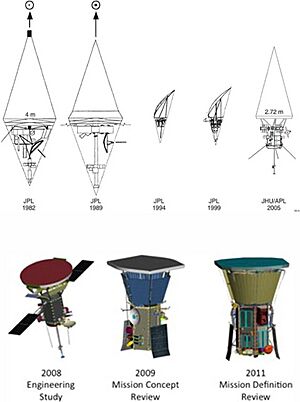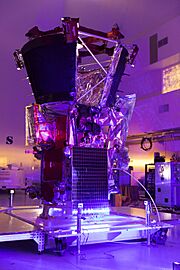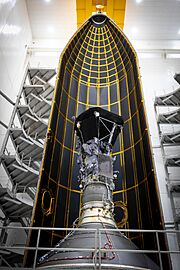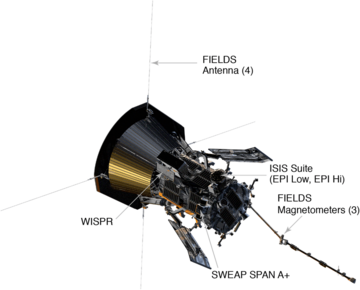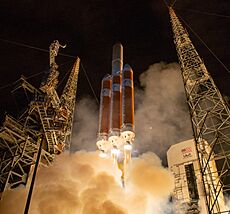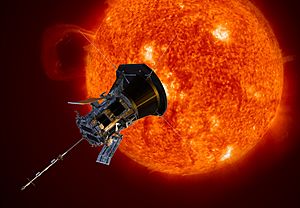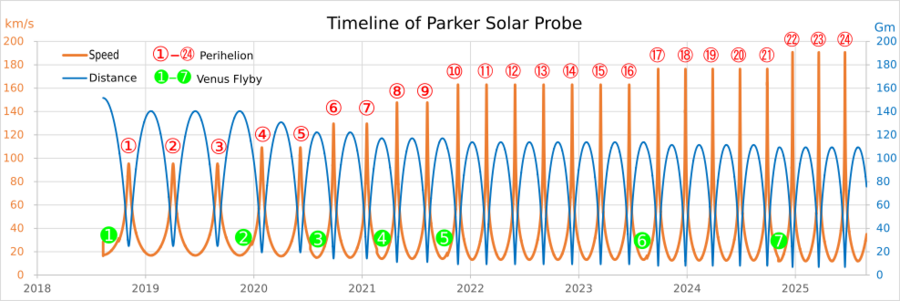Parker Solar Probe facts for kids
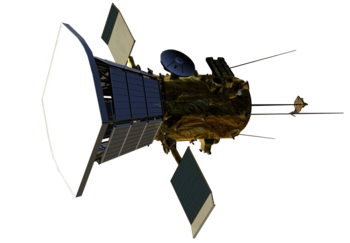
Model of the Parker Solar Probe
|
|
| Names | Solar Probe (before 2002) Solar Probe Plus (2010–2017) Parker Solar Probe (since 2017) |
|---|---|
| Mission type | Heliophysics |
| Operator | NASA / Applied Physics Laboratory |
| Mission duration | 7 years (planned) Elapsed: 7 years, 4 months and 16 days |
| Spacecraft properties | |
| Manufacturer | Applied Physics Laboratory |
| Launch mass | 685 kg (1,510 lb) |
| Dry mass | 555 kg (1,224 lb) |
| Payload mass | 50 kg (110 lb) |
| Dimensions | 1 × 3 × 2.3 m (3.3 × 9.8 × 7.5 ft) |
| Power | 343 W (at closest approach) |
| Start of mission | |
| Launch date | 12 August 2018, 07:31 UTC |
| Rocket | Delta IV Heavy / Star 48BV |
| Launch site | Cape Canaveral, SLC‑37 |
| Contractor | United Launch Alliance |
| Orbital parameters | |
| Reference system | Heliocentric orbit |
| Semi-major axis | 0.388 AU (58.0 million km; 36.1 million mi) |
| Perihelion | 0.046 AU (6.9 million km; 4.3 million mi; 9.86 R☉) |
| Aphelion | 0.73 AU (109 million km; 68 million mi) |
| Inclination | 3.4° |
| Period | 88 days |
 Mission insignia Large Strategic Science Missions
Heliophysics Division |
|
The Parker Solar Probe (PSP) is a NASA space probe launched in 2018. Its main job is to study the Sun's outer atmosphere, called the corona.
It uses gravity assists from Venus to get closer to the Sun. At its closest, it came within 6.9 million kilometers (4.3 million miles) of the Sun's center. In 2024, it reached a speed of 191 km/s (118.7 mi/s) relative to the Sun. This made it the fastest object ever built on Earth.
The project was announced in 2009. The Johns Hopkins University Applied Physics Laboratory built the spacecraft. It launched on August 12, 2018. It was the first NASA spacecraft named after a living person, honoring physicist Eugene Newman Parker.
On October 29, 2018, the spacecraft became the closest artificial object to the Sun. The previous record was held by the Helios 2 spacecraft in 1976. The Parker Solar Probe has made many close approaches since then.
On December 24, 2024, the PSP made its closest approach to the Sun. It came within 6.1 million km (3.8 million miles) of the Sun's surface. A signal received on December 26 confirmed it survived this journey. Detailed information was received on January 1, 2025.
In 2025, the teams behind the mission won the 2024 Collier Trophy. This award recognized their amazing achievements.
Contents
Mission History
The idea for a solar probe began in 1958. Scientists wanted a spacecraft to fly close to the Sun. They hoped to study particles and fields near it.
Studies in the 1970s and 1980s showed how important this mission was. But it was always too expensive to build. In the 1990s, a cheaper version was considered.
The first design for the Solar Probe used gravity assist from Jupiter. This would send it into a special orbit that went very close to the Sun's poles. This design was very expensive. It also needed a special power source.
Later, in the early 2010s, a new plan was made. This plan was called Solar Probe Plus. It was much cheaper. This new design uses several Venus gravity assists. It also uses solar panels for power.
In May 2017, the spacecraft was renamed the Parker Solar Probe. This honored astrophysicist Eugene Newman Parker. He had suggested the idea of solar wind. The mission cost NASA about US$1.5 billion.
A memory card with over 1.1 million names was placed on the spacecraft. It also held photos of Eugene Parker. His 1958 paper about solar physics was also on the card.
Spacecraft Design
The Parker Solar Probe is the first spacecraft to fly into the Sun's lower corona. It studies the Sun's plasma and magnetic field. It also looks at how the corona gets hot and how solar wind is created.
Solar Shield Protection
The spacecraft has a special solar shield to protect it from the Sun's extreme heat. At its closest point, the Sun's heat is 475 times stronger than at Earth. The shield is hexagonal and faces the Sun.
It is 2.3 meters (7.5 feet) wide and 11.4 cm (4.5 inches) thick. It is made of two layers of carbon composite with a light carbon foam inside. This shield can handle temperatures of about 1,370 degrees Celsius (2,500 degrees Fahrenheit). The shield weighs only 72.5 kg (160 lbs). It keeps the instruments inside at a cool 29 degrees Celsius (85 degrees Fahrenheit).
The shield has a white surface that reflects sunlight. All the spacecraft's systems and instruments are hidden in the shield's shadow. Without the shield, the probe would be destroyed in seconds.
Because radio signals take about eight minutes to reach Earth, the probe must protect itself. It uses four light sensors to detect sunlight peeking around the shield. If this happens, it quickly moves itself back into the shadow. Scientists call it "the most autonomous spacecraft that has ever flown."
Power System
The probe gets its power from two sets of solar panels. The main set is used when the probe is farther from the Sun. When it gets close, these panels retract behind the shield. A smaller set of panels then takes over. These smaller panels have a special cooling system. This keeps them and the instruments at the right temperature.
Journey to the Sun
The Parker Solar Probe's journey involves many gravity assists from Venus. These flybys slowly shrink its orbit around the Sun. This allows it to get closer and closer. The spacecraft has completed seven Venus flybys over nearly seven years. It has made 24 orbits around the Sun.
The journey needed a very powerful rocket. The probe launched on a Delta IV Heavy launch vehicle. It also used a special upper stage rocket. As the probe flew around the Sun in December 2024, it reached a speed of 191 km/s (118.7 mi/s). This made it the fastest human-made object ever. It was almost three times faster than the previous record holder, Helios-2.
The launch was very accurate. But small adjustments were still needed to save fuel. The first Venus flyby happened just 52 days after launch.
According to Kepler's laws of planetary motion, objects speed up as they get closer to a star or planet. The Parker Solar Probe speeds up a lot as it nears the Sun. For example, during a close approach on September 27, 2023, it traveled at 176.5 km/s (394,736 miles per hour). That's fast enough to fly from New York to Tokyo in just over a minute!
Final Orbit and Mission End
The final gravity assist for the Parker Solar Probe happened on November 6, 2024. This put the spacecraft into a new orbit. It passes 6.1 million kilometers (3.8 million miles) from the Sun's surface. A signal received on December 20, 2024, confirmed the craft was working well. The closest approach happened on December 24, 2024. Another signal on December 26 confirmed it survived.
This final orbit is inside the orbit of Venus. No more Venus encounters are planned. The probe will continue in this orbit. It will need small adjustments to keep its antennas pointed at Earth. Eventually, its fuel for these adjustments will run out. When that happens, the plan is to turn the craft so its instruments face the Sun directly. This will destroy them. However, the heat shield is expected to keep orbiting the Sun for millions of years.
Scientific Instruments
The Parker Solar Probe has four main instruments:
- FIELDS (Electromagnetic Fields Investigation): This instrument measures electric and magnetic fields in the Sun's atmosphere. It helps scientists understand how the Sun's magnetic field changes. It also studies waves and turbulence in the solar wind. FIELDS uses five antennas, four of which stick out into the sunlight. These antennas can handle extreme temperatures.
- IS☉IS (Integrated Science Investigation of the Sun): This instrument measures different types of particles. It helps scientists understand where these particles come from. It also studies how they speed up and move away from the Sun. IS☉IS has two parts: EPI-Lo and EPI-Hi. They measure particles at different energy levels.
- WISPR (Wide-field Imager for Solar Probe): These are special cameras that take pictures of the Sun's corona and the inner heliosphere. WISPR uses two cameras with tough detectors. Their lenses are made of a special glass that can handle radiation and dust impacts.
- SWEAP (Solar Wind Electrons Alphas and Protons): This instrument counts electrons, protons, and helium ions. It measures their speed, density, and temperature. It has two main parts: the Solar Probe Analyzers (SPAN) and the Solar Probe Cup (SPC). The SPC sticks out from behind the heat shield. It measures particles directly from the Sun. SPAN has a wide view to see parts of space not covered by SPC.
Mission Timeline
The Parker Solar Probe launched on August 12, 2018. It worked perfectly after launch. In its first week, it set up its antennas and other parts. It made its first path correction on August 20, 2018.
Instrument testing began in September 2018. On September 9, 2018, the WISPR cameras took their first pictures. They sent back wide-angle images of the sky.
The probe completed its first Venus flyby on October 3, 2018. It came within about 2,400 km (1,500 miles) of Venus. This helped slow the probe down and move it closer to the Sun.
When the Parker Solar Probe is close to the Sun, it enters its "Science Phase." During this time, it actively collects data. Communication with Earth is mostly cut off then. These science phases last for a few days around each closest approach to the Sun.
Most of the rest of the orbit is used to send data back to Earth. But even then, communication can be difficult. Sometimes the heat shield blocks the signal. Other times, the Sun's radiation can interfere with the radio link.
The probe's orbit changed after each Venus flyby. Its orbital period around the Sun got shorter and shorter. After the seventh and final Venus flyby in November 2024, its period became about 88 days. This allowed it to get closer to the Sun than ever before.
| Year | Date | Event | Perihelion distance (Gm) |
Speed (km/s) |
Orbital period (days) |
Notes |
|---|---|---|---|---|---|---|
| 2018 | 12 August | Launch | 151.6 | – | 174 | |
| 3 October | Venus flyby #1 | 2548 km altitude | Inbound | Inside Venus's orbit | This flyby helped slow the probe down. | |
| 6 November | Perihelion #1 | 24.8 | 95 | 150 | First close approach to the Sun. | |
| 2019 | 4 April | Perihelion #2 | 24.8 | 95 | 150 | |
| 1 September | Perihelion #3 | 24.8 | 95 | 150 | ||
| 26 December | Venus flyby #2 | 3023 km altitude | Inbound | Inside Venus's orbit | Further reduced the probe's speed. | |
| 2020 | 29 January | Perihelion #4 | 19.4 | 109 | 130 | |
| 7 June | Perihelion #5 | 19.4 | 109 | 130 | ||
| 11 July | Venus flyby #3 | 834 km altitude | Outbound | Outside Venus's orbit | The probe passed through Venus's shadow and tail. | |
| 27 September | Perihelion #6 | 14.2 | 129 | 112.5 | ||
| 2021 | 17 January | Perihelion #7 | 14.2 | 129 | 112.5 | |
| 20 February | Venus flyby #4 | 2392 km altitude | Outbound | Outside Venus's orbit | ||
| 28 April | Perihelion #8 | 11.1 | 147 | 102 | This was the first time the probe entered the solar corona. | |
| 9 August | Perihelion #9 | 11.1 | 147 | 102 | ||
| 16 October | Venus flyby #5 | 3786 km altitude | Inbound | Inside Venus's orbit | ||
| 21 November | Perihelion #10 | 9.2 | 163 | 96 | ||
| 2022 | 25 February | Perihelion #11 | 9.2 | 163 | 96 | |
| 1 June | Perihelion #12 | 9.2 | 163 | 96 | ||
| 6 September | Perihelion #13 | 9.2 | 163 | 96 | ||
| 11 December | Perihelion #14 | 9.2 | 163 | 96 | ||
| 2023 | 17 March | Perihelion #15 | 9.2 | 163 | 96 | |
| 22 June | Perihelion #16 | 9.2 | 163 | 96 | ||
| 21 August | Venus flyby #6 | 3939 km altitude | Inbound | Inside Venus's orbit | ||
| 27 September | Perihelion #17 | 7.9 | 176 | 92 | ||
| 29 December | Perihelion #18 | 7.9 | 176 | 92 | ||
| 2024 | 30 March | Perihelion #19 | 7.9 | 176 | 92 | |
| 30 June | Perihelion #20 | 7.9 | 176 | 92 | ||
| 30 September | Perihelion #21 | 7.9 | 176 | 92 | ||
| 6 November | Venus flyby #7 | 317 km altitude | Outbound | Outside Venus's orbit | This was the final Venus flyby. | |
| 24 December | Perihelion #22 | 6.9 | 192 | 88 | The closest approach to the Sun. | |
| 2025 | 22 March | Perihelion #23 | 6.9 | 192 | 88 | |
| 19 June | Perihelion #24 | 6.9 | 192 | 88 | ||
| 15 September | Perihelion #25 | 6.9 | 192 | 88 | ||
| 12 December | Perihelion #26 | 6.9 | 192 | 88 |
Discoveries and Findings
On November 6, 2018, the Parker Solar Probe saw its first "magnetic switchbacks." These are sudden flips in the direction of the Sun's magnetic field. They were first seen by the Ulysses mission. Switchbacks help heat the Sun's corona.
In December 2019, the first research papers about the probe's findings were published. They showed how the Sun's magnetic field changes. They also described frequent, short changes in the field's direction. These measurements helped confirm ideas about why the Sun's corona is so hot. The probe saw about a thousand "rogue" magnetic waves. These waves can make solar wind speeds increase very quickly.
Researchers also found that the Sun's magnetic field reversals are linked to faster plasma speeds. They also found a surprisingly large sideways speed of the plasma. This speed comes from the Sun's rotation. It slingshots plasma out of the corona.
The PSP also found a zone around the Sun that is free of cosmic dust. This zone is about 5.6 million kilometers (3.5 million miles) wide. The Sun's radiation vaporizes dust particles in this area.
On April 28, 2021, the Parker Solar Probe "touched the Sun." During its eighth flyby, it entered the Alfvén surface. This is where the Sun's magnetic field controls the solar wind. The probe's instruments measured the plasma there.
On September 25, 2022, the probe made its first comet discovery. The comet was named PSP-001. It was found in images from May 29, 2022. Since then, 19 more sungrazing comets have been found in the probe's images.
| Designation | Comet classification | Image date | Discovery date | Discoverer |
|---|---|---|---|---|
| PSP-001 | Kreutz | 29 May 2022 | 25 Sep 2022 | Peter Berrett |
| PSP-002 | Kreutz | 1 Sep 2022 | N/A | Karl Battams |
| PSP-003 | Kreutz | 2 Sep 2022 | N/A | Karl Battams |
| PSP-004 | Kreutz | 1 Sep 2022 | N/A | Karl Battams |
| PSP-005 | Kreutz | 18 Nov 2021 | 11 Feb 2023 | Peter Berrett |
| PSP-006 | Non Group | 11 Dec 2022 | 13 May 2023 | Peter Berrett |
| PSP-007 | Kreutz | 12 Mar 2023 | 12 Jul 2023 | Karl Battams |
| PSP-008 | Non Group | 6 Dec 2022 | 16 Jul 2023 | Rafał Biros |
| PSP-009 | Kreutz | 25 Apr 2021 | 28 Jul 2023 | Rafał Biros |
| PSP-010 | Kreutz | 25 Apr 2021 | 28 Jul 2023 | Rafał Biros |
| PSP-011 | Kreutz | 17 Nov 2021 | 24 Jul 2023 | Rafał Biros |
| PSP-012 | Kreutz | 21 Feb 2022 | 30 Jul 2023 | Rafał Biros |
| PSP-013 | Kreutz | 15 Feb 2022 | 27 Jul 2022 | Peter Berrett |
| PSP-014 | Kreutz | 4 Aug 2021 | 3 Aug 2023 | Rafał Biros |
| PSP-015 | Kreutz | 5–6 Aug 2021 | 3 Aug 2023 | Rafał Biros |
| PSP-016 | Kreutz | 29 May 2022 | 4 Aug 2023 | Rafał Biros |
| PSP-017 | Kreutz | 12 Jan 2021 | 16 Aug 2023 | Robert Pickard |
| PSP-018 | Kreutz | 19 Jun 2023 | 13 Oct 2023 | Peter Berrett |
| PSP-019 | Non Group | 27 Sep 2023 | 2 Nov 2023 | Guillermo Stenborg |
| PSP-020 | Kreutz | 13 Jan 2021 | 8 Aug 2023 | Peter Berrett |
In 2024, the probe detected a Kelvin-Helmholtz instability (KHI). This happened during a coronal mass ejection. It was the first time a spacecraft had detected this event.
Working with Solar Orbiter
The Parker Solar Probe and the ESA-NASA Solar Orbiter (SolO) missions work together. They track solar wind and other events from the Sun to inner space.
In 2022, PSP and SolO teams studied why the Sun's atmosphere is "150 times hotter" than its surface. SolO observed the Sun from far away. PSP observed the Sun's corona up close at the same time. This allowed scientists to compare data from both probes.
In March 2024, both probes were at their closest points to the Sun. PSP was 7.3 million km away. SolO was 45 million km away. SolO observed the Sun, while PSP sampled the solar wind. This helped scientists learn even more.
Images for kids
-
Photo taken by the probe during its second Venus flyby, July 2020.
See also
 In Spanish: Sonda Solar Parker para niños
In Spanish: Sonda Solar Parker para niños
- Living With a Star
- List of heliophysics missions
- List of vehicle speed records
- Spacecraft thermal control


